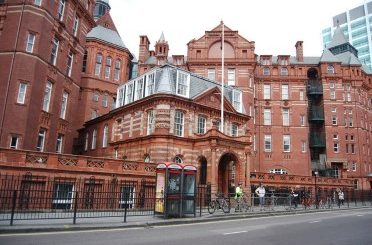St Nicholas’s Churchyard, Chiswick
St Nicholas’s Church on Church Street in Chiswick is reputedly haunted by two of Oliver Cromwell’s daughters and there is even a legend associated with the church suggesting that the Lord Protector himself may have finally found peace there.
Though the current building of St Nicholas’s Church designed by , John Loughborough Pearson dates from around 1882 – 1884, there has been a church on this site since 1181 and the tower dates from between 1416 and 1435. In the 7th Century a pagan site on the site was converted to Christianity and this was still in existence during Edward the Confessor’s reign.
 Oliver Cromwell, regicide and Lord Protector died (probably of septicaemia) at Whitehall on Friday 3 September 1658 was subsequently buried at Westminster Abbey where one of his daughters, 29 year old Lady Elizabeth Claypole who had died on 6 August 1658 was also interred.
Oliver Cromwell, regicide and Lord Protector died (probably of septicaemia) at Whitehall on Friday 3 September 1658 was subsequently buried at Westminster Abbey where one of his daughters, 29 year old Lady Elizabeth Claypole who had died on 6 August 1658 was also interred.
He was succeeded as Lord Protector by his son Richard, who was forced to resign the position in May 1659 and in 1660 the exiled monarchy was invited to return and be restored. King Charles II had Cromwell’s body exhumed on 26 January 1661 and on 30 January 1661 it was beheaded after being hung on gallows all day, as a symbolic execution marking the date of King Charles I’s own death in 1649. Between being exhumed and being taken to Tyburn, the body of Cromwell may have been taken to the Red Lion Inn. The body of Cromwell was hung in chains at Tyburn before being discarded in a pit and his head was displayed on a outside Westminster Hall on a pole until 1684. On 26th March 1960, his head was eventually buried as Sidney Sussex College, Cambridge, where Cromwell attended.
There is a story that after his body was thrown in the Tyburn burial pit, his daughters, Mary and Frances arranged with a guard to secretly reclaim the corpse. The body was then supposed to have been hidden in the family crypt at St Nicholas’s Church. During the reconstruction in 1882, it is said the vicar investigated the crypt and found an extra coffin. Fearful of tourists this might attract he bricked the vault up and it remains lost to this day. Mary and Frances are said to haunt the churchyard, possibly because their graves are now essentially unmarked.
Lady Mary Fauconberg (1637-1713)
 Mary who resembled her father was the third daughter of Oliver Cromwell and married Thomas Belasyse, Viscount (later Earl) Fauconberg in 1657. She was described as `a wise and worthy woman, more likely to have maintained the post of Protector than either of her two brothers’ by Bishop Burnet. Earl Fauconberg died in 1700 and Mary who lived at Sutton Court died in 1713. She was buried in a vault in the chancel of St Nicholas’s. Whilst alive Earl Fauconberg had paid to have the chancel repaired.
Mary who resembled her father was the third daughter of Oliver Cromwell and married Thomas Belasyse, Viscount (later Earl) Fauconberg in 1657. She was described as `a wise and worthy woman, more likely to have maintained the post of Protector than either of her two brothers’ by Bishop Burnet. Earl Fauconberg died in 1700 and Mary who lived at Sutton Court died in 1713. She was buried in a vault in the chancel of St Nicholas’s. Whilst alive Earl Fauconberg had paid to have the chancel repaired.
Lady Frances Russell (1638- January 1721)
Frances was the youngest child of Oliver Cromwell. In 1657, at the age of nineteen she married Robert Rich, grandson of Robert, 2nd Earl of Warwick, who unfortunately died in 1658 (the same year as Oliver Cromwell and her older sister Elizabeth), leaving Frances a young widow. Shortly after the restoration of the monarchy Frances married Sir John Russell, 3rd Baronet of Chippenham, giving him five children, William, Rich, John, Christian and Elizabeth. Sir John died in 1669, again leaving Frances a widow, this time aged 32. The latter part of Frances’s life was spent with her sister Mary. After a short illness Frances died in January 1721, aged 82 years and she was the last of Oliver Cromwell’s children to die. She was laid to rest in the chancel of St Nicholas’s with her sister.
The church and churchyard of St Nicholas’s is te final resting place for many notable people and has thirty listed memorials. Those who’s graves can be found include:
Private Frederick Hitch, VC (Died 6th January 1913 ) (1362 B Company, 24th Regiment – Survivor of Rorke’s Drift)
Sir William Blake Richmond (29 November 1842 – February 11, 1921) (Artist)
William Hogarth (10 November 1697 – 26 October 1764) (Artist)
James Abbott McNeill Whistler (July 11, 1834 – July 17, 1903) (Artist)
Sir Charles Tilston Bright (8 June 1832 – 3 May 1888) (Electrical Engineer)
Hon. Thomas Walpole
William Kent (1685 – 12 April 1748), (Architect)
Phillip James de Loutherbourg (31 October 1740 – 11 Marchh 1812) (Artist)
Barbara Villiers, 1st Duchess of Cleveland (1640 – 9 October 1709) (Mistress of King Charles II) – Died at Walpole House, Chiswick.
Charles Holland (1733–1769) (Actor)
Grace Charlotte, Duchess of Somerset (Died 1773)
Whether Cromwell is actually buried at St Nicholas’s Church is unknown, as is whether his two daughters haunt the building and grounds as I have not found any witness reports. Other possible locations for the location of his body include, obviously the burial pit at Tyburn, the Cromwell vault in Newburgh Priory and under the Naseby battlefield.




Re: St Nicholas’s Churchyard, Chiswick
This image shows the symblic execution of Oliver Cromwells corpse on 30th January 1661 after it had been exhumed four days earlier from Westminster Abbey.
[img_assist|nid=2452|title=Cromwell’s Execution|desc=|link=none|align=center|width=500|height=404]